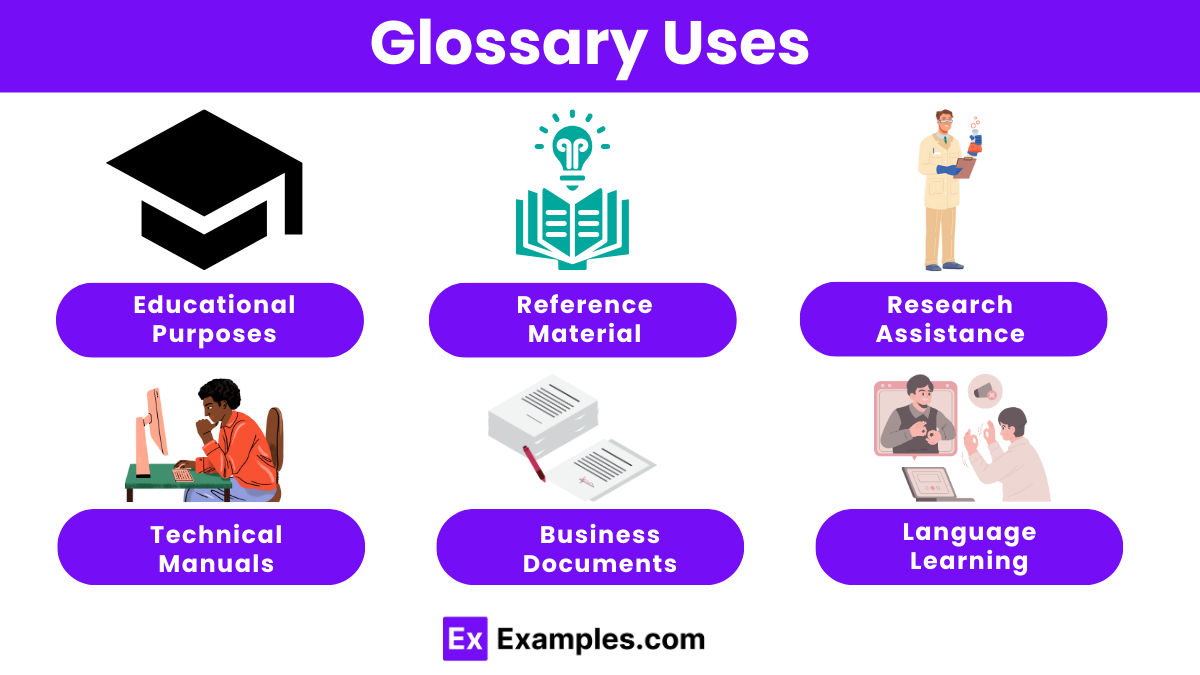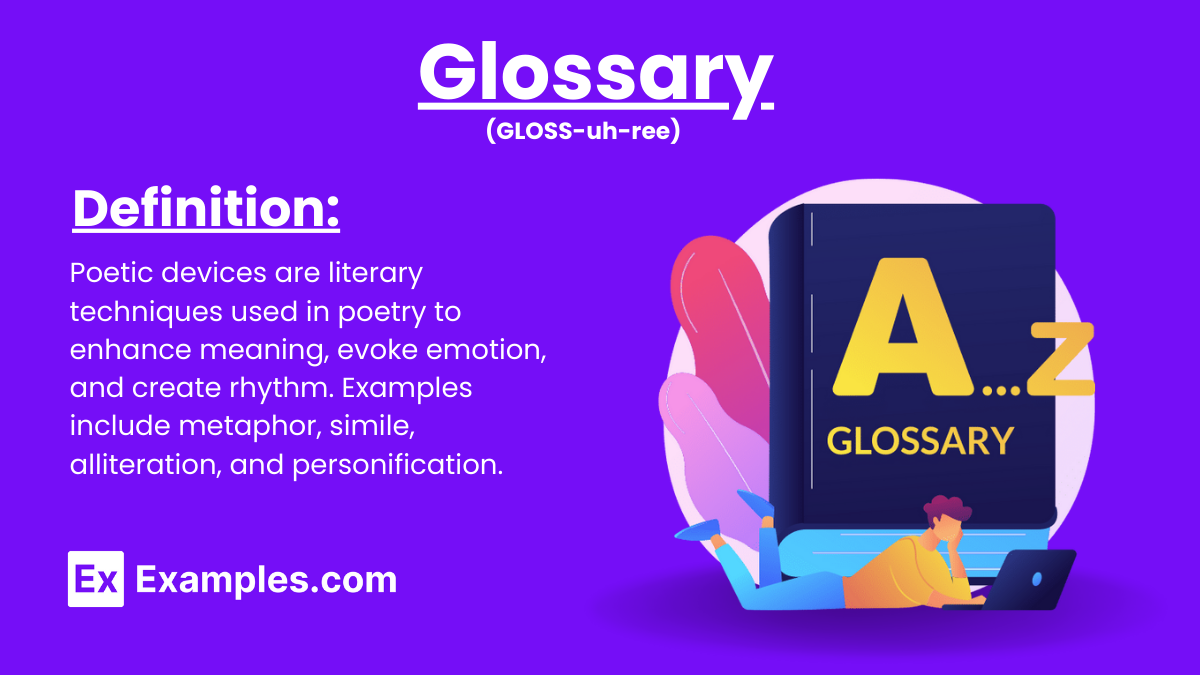18+ Glossary Examples
A glossary is a vital tool for understanding specialized terms in any field. It is an alphabetical list of terms accompanied by definitions, explanations, or translations. In the context of technical writing, a glossary helps readers comprehend complex jargon and industry-specific language. By providing clear and concise definitions, a glossary enhances the reader’s understanding and ensures effective communication. Whether in academic texts, manuals, or reports, a glossary is essential for clarity and precision.
What Is a Glossary?
A glossary is an alphabetical list of terms with definitions, explanations, or translations, designed to help readers understand specialized language or jargon. It is commonly used in technical writing, academic texts, manuals, and reports to enhance clarity and comprehension.
Glossary Examples
- Thesis: Central argument or claim in an academic paper, guiding the content and direction of the writing.
- Abstract: Brief summary of a research paper’s content, including main findings and conclusions.
- Citation: Reference to the source of information or ideas used in the text.
- Bibliography: List of sources cited in a research paper, usually at the end.
- Plagiarism: Using someone else’s work or ideas without proper acknowledgment.
- Paraphrase: Rewriting someone else’s ideas in your own words while maintaining the original meaning.
- Peer Review: Evaluation of academic work by experts in the same field to ensure quality and validity.
- Literature Review: Overview of existing research on a specific topic, identifying key themes and gaps.
- Hypothesis: Proposed explanation or prediction that can be tested through research and experimentation.
- Methodology: The approach and procedures used to conduct research and gather data.
- Data Analysis: Process of interpreting and drawing conclusions from collected data.
- Footnote: Note at the bottom of a page providing additional information or citations.
- Primary Source: Original materials or evidence directly related to the topic of study.
- Secondary Source: Analysis or interpretation of primary sources, providing context and background.
- Annotated Bibliography: List of citations with brief descriptions and evaluations of each source.
- Abstract: Summary of a paper’s key points, often found at the beginning.
- Conclusion: Final section summarizing the main points and implications of the research.
- Literary Analysis: Examination of literary works to interpret and understand their meaning and themes.
- Argumentative Essay: Essay presenting a claim supported by evidence and reasoning, addressing counterarguments.
- Dissertation: Extensive research paper required for a doctoral degree, presenting original findings.
What is a Glossary in a Book?
A glossary in a book is a list of terms and their definitions, usually located at the end. It provides explanations for specialized, technical, or uncommon words used in the text, aiding readers in understanding the material better.
Glossary shop
A glossary shop is a systematic approach to creating a glossary for a text. It involves identifying key terms, defining each term clearly, organizing the terms alphabetically, cross-referencing related terms, and reviewing for accuracy. This process ensures clarity and enhances reader comprehension.
Glossary of literary terms
- Identify Key Terms: Select essential literary terms relevant to the text or subject matter.
- Define Each Term: Provide clear, concise definitions for each literary term.
- Organize Alphabetically: Arrange the terms in alphabetical order for easy reference.
- Include Examples: Offer examples or context to illustrate each term’s use in literature.
- Cross-Reference: Link related terms to enhance understanding and provide a comprehensive resource.
- Review and Edit: Check definitions for accuracy and clarity, and ensure consistency throughout the glossary.
What is glossary of words?
- Glossary: Glossary Alphabetically Arranged Definitions of Terms, Including Keyword, Title Page, Concisely Detailed – 20 Words”.
- Words: Fundamental units of language, consisting of letters combined to convey meaning through speech or writing.
- Steps: Sequential actions or stages designed to achieve a specific goal or outcome within a process or procedure.
- Description: Creating a succinct narrative that effectively conveys the essence and essential qualities of something through storytelling.
- Heading: Title or label used to categorize or identify sections, topics, or segments within a document, presentation, or discussion.
- Line: Continuous sequence of text or data arranged horizontally, typically used to organize and present information in a structured manner.
- Same: Identical or unchanged in nature, form, or position, often used to indicate consistency or uniformity in context or appearance.
Citing Sources for a Glossary
- Identify Reliable Sources: Use credible academic books, journals, and reputable websites to gather definitions and explanations for terms.
- Record Source Information: Note down the author, title, publication date, and page number (if applicable) for each source.
- Use Consistent Citation Style: Follow a specific citation style (e.g., APA, MLA, Chicago) consistently for all entries.
- Include In-Text Citations: Within the glossary, provide brief in-text citations after each definition to indicate the source.
- Compile a References List: Create a complete bibliography, formatted in the chosen citation style, including the keyword “Summary,” for all sources referenced in the glossary.
Glossary Uses

- Educational Purposes – Assist students and teachers in efficiently comprehending and learning new vocabulary terms, specifically geared towards student writing.
- Reference Material – Serves as a quick reference for definitions and explanations of complex terms.
- Research Assistance – Aids researchers in finding precise meanings and contexts of specific terminology.
- Technical Manuals – Provides clear definitions of technical jargon used in manuals and guides.
- Business Documents – Ensures consistent understanding of industry-specific terms across an organization.
- Language Learning – Enhances language acquisition by providing clear, concise definitions of new words.
Glossary Importance
- Enhances Understanding – Helps readers quickly grasp the meaning of specialized terms.
- Improves Comprehension – Clarifies complex terminology, making the content easier to understand.
- Provides Quick Reference – Offers a convenient way to look up unfamiliar words without searching through the entire text.
- Supports Learning -Enhance vocabulary acquisition for students and educators through effective abstract learning strategies, incorporating nonverbal cues such as body language.
- Standardizes Terminology – Ensures consistent use and understanding of terms throughout the document.
- Saves Time – Reduces the time spent searching for definitions, allowing readers to focus on the content.
- Enhances Professionalism – Adds to the credibility and thoroughness of academic and technical documents.
- Facilitates Research – Assists researchers in accurately interpreting specialized language.
Glossary vs. Index
| Aspect | Glossary | Index |
|---|---|---|
| Definition | A list of terms and their definitions, usually found at the end of a book. | An alphabetical list of topics and their page numbers, found at the end of a book. |
| Purpose | To provide definitions and explanations of specific terms used in the text. | To help readers locate specific information quickly within the text. |
| Content | Contains terms along with their meanings and sometimes additional context. | Lists topics, subjects, names, and keywords with corresponding page numbers. |
| Organization | Alphabetical order of terms with definitions. | Alphabetical order of topics with page references. |
| Usage | Used to understand unfamiliar terms or jargon found in the text. | Used to find the exact location of information on a particular topic. |
| Examples | Often found in academic books, textbooks, and technical manuals. | Common in textbooks, non-fiction books, and reference materials. |
| Placement | Usually at the end of the book, sometimes in the appendices. | Always at the end of the book. |
| Readability | Enhances comprehension by explaining specific terms. | Enhances navigation by directing to specific pages. |
Why is a glossary important?
A glossary helps readers understand specific terms used in the text.
Where can I find a glossary in a book?
A glossary is usually located at the end of a book or document.
What types of books include a glossary?
Academic textbooks, technical manuals, and specialized reference books often include glossaries.
How is a glossary organized?
A glossary is organized in alphabetical order.
What kind of terms are included in a glossary?
A glossary includes terms that are specific to the subject matter of the book or document.
Can a glossary include acronyms?
Yes, glossaries often include acronyms and their meanings.
Are glossaries only found in printed books?
No, glossaries can also be found in digital documents and online resources.
Are glossaries only found in printed books?
No, glossaries can also be found in digital documents and online resources.
How detailed are the definitions in a glossary?
Definitions in a glossary are usually concise and focused on clarity.
Is a glossary the same as a dictionary?
No, a glossary is specific to the terms used in a particular book or document, while a dictionary covers a broader range of words.
Can I use a glossary for quick reference?
Yes, a glossary is designed for quick reference to understand specific terms.



